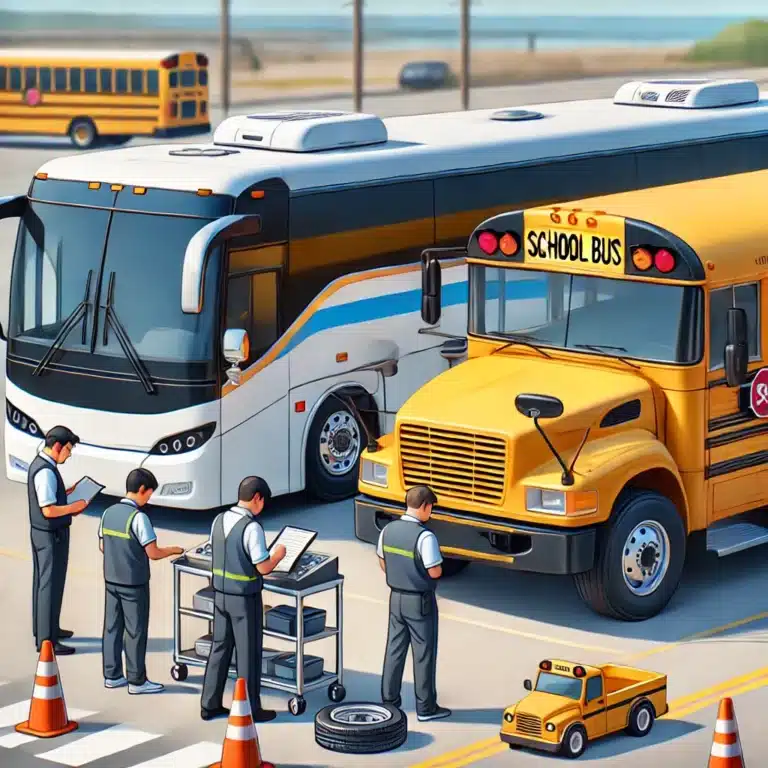Passenger Bus vs. School Bus CDL: Key Differences, Endorsements, and Training Requirements
 When it comes to driving buses, a Commercial Driver’s License (CDL) isn’t a one-size-fits-all credential. Although both passenger buses and school buses fall under the umbrella of commercial vehicles, the requirements, endorsements, and training for each differ significantly. Below is an in-depth look at the differences between a CDL for a passenger bus and one for a school bus.
When it comes to driving buses, a Commercial Driver’s License (CDL) isn’t a one-size-fits-all credential. Although both passenger buses and school buses fall under the umbrella of commercial vehicles, the requirements, endorsements, and training for each differ significantly. Below is an in-depth look at the differences between a CDL for a passenger bus and one for a school bus.
Overview of Bus CDLs
Both types of buses require a CDL, which is designed to ensure that drivers have the necessary skills and knowledge to operate large vehicles safely. However, because the responsibilities and operating environments can vary greatly between transporting the general public and transporting schoolchildren, additional endorsements and specialized training are mandated—especially for school bus drivers.
Passenger Bus CDL
Purpose and Scope
- Passenger Transport: A passenger bus CDL typically qualifies drivers to operate vehicles designed to carry a significant number of passengers, such as city transit buses, charter buses, or intercity coaches.
- Endorsement: Most states require a “Passenger” (P) endorsement added to the CDL. This endorsement verifies that the driver has received training on safely operating a bus with multiple passengers.
- Training Focus: Training for a passenger bus CDL emphasizes:
- General bus operation and maneuvering techniques.
- Pre-trip inspections and vehicle maintenance.
- Safe driving practices in various traffic and weather conditions.
- Handling passenger emergencies and ensuring overall passenger safety.
Regulatory Requirements
- Written and Skills Tests: Candidates must pass both a knowledge test (covering topics like traffic laws and bus operation) and a skills test (covering pre-trip inspections, basic vehicle control, and on-road driving).
- Medical Certification: Like all CDL holders, passenger bus drivers must meet specific medical standards to ensure they are physically capable of handling the demands of the job.
School Bus CDL
Enhanced Responsibility
- Student Safety: The primary difference for school bus drivers is the increased responsibility of transporting children. This added duty necessitates more rigorous safety protocols.
- Additional Endorsement: Most states require a separate “School Bus” (S) endorsement. This endorsement confirms that the driver has completed additional training specific to the unique challenges of operating a school bus.
- Specialized Training: School bus training programs often include:
- Student Management: Techniques for managing student behavior and ensuring safety during boarding, riding, and disembarking.
- Emergency Procedures: Drills and protocols specifically tailored for evacuating children in emergencies.
- Defensive Driving: Enhanced defensive driving tactics focused on routes commonly used by school buses, which often include school zones with lower speed limits and increased pedestrian activity.
- Additional Background Checks: Due to the vulnerability of the passengers, school bus drivers usually undergo comprehensive background checks, including criminal history reviews and fingerprinting.
Regulatory and Operational Differences
- State-Specific Requirements: While the federal standards set the baseline, many states impose extra requirements for school bus drivers. These might include periodic re-certification or additional safety courses.
- Insurance and Liability: Given the high stakes involved in transporting children, school bus operations often have distinct insurance requirements, and drivers might be subject to more rigorous monitoring and disciplinary processes.
Key Differences Summarized
-
Endorsements:
- Passenger Bus: Requires a Passenger (P) endorsement on the CDL.
- School Bus: Requires both a Passenger (P) endorsement and a School Bus (S) endorsement, each reflecting specialized training.
-
Training Focus:
- Passenger Bus: Concentrates on general bus operation, safety inspections, and passenger safety for a broad audience.
- School Bus: Includes additional modules on child behavior management, emergency evacuation procedures, and enhanced defensive driving techniques in school zones.
-
Background Checks:
- Passenger Bus: Standard background checks and driving record evaluations.
- School Bus: More extensive background checks to ensure the driver’s suitability to work with children.
-
Operational Environment:
- Passenger Bus: May operate on a variety of routes including urban, suburban, and intercity roads.
- School Bus: Typically operates on fixed routes within local school districts, often with stricter speed limits and designated school zones.
Conclusion
While both passenger bus and school bus CDLs require a solid foundation of commercial driving skills, the additional requirements for school bus drivers highlight the increased responsibility of transporting young passengers. By meeting these stricter standards—through extra endorsements, specialized training, and enhanced background checks—school bus drivers are uniquely prepared to handle the challenges of ensuring student safety on the road.
Understanding these differences not only clarifies the regulatory landscape but also underscores the importance of tailored training for different types of commercial driving roles. Whether you aim to drive a passenger bus or a school bus, the right preparation and adherence to state and federal guidelines will help pave the way to a safe and rewarding career.
